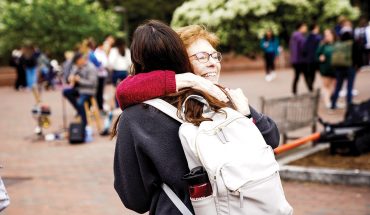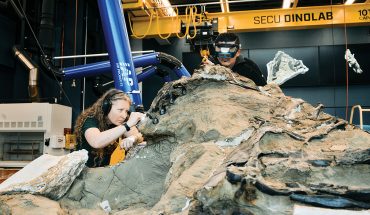by Hampton Williams Hofer
photographs by Nick Pironio
Any tennis player will tell you that the most coveted trophy outside of the professional circuit is the gold ball. No bigger than the nail on your pointer finger, the gold ball is a charm that hangs against a velvet background in a wooden box, signifying a national championship victory. Paul Goode, the Raleigh Racquet Club’s director of tennis, has three of them – one just five months old. They sit, unassuming, on his desk in a clubhouse office he rarely occupies.
Unlike most Division 1 college tennis players who picked up a racquet as soon as they could walk, Goode, 36, spent the better part of his childhood in Boone on skis. It wasn’t until age 11 that he stumbled upon the hard courts at Watauga County Parks-and-Rec and discovered tennis for the first time. With little formal training, he went on to dedicate the next two and a half decades of his life to mastering – and now also teaching – the sport.
For many of Raleigh’s most promising young tennis players, Goode is the coach he never had. Thorne Gregory, a high school junior who left his family in Connecticut and moved to Raleigh in order to train with Goode, says his mentor’s influence has transcended tennis. “I’ve learned as much from Paul as a person as I have from him as a coach. In addition to pushing me beyond what I previously considered my limits both physically and mentally, Paul is constantly encouraging me to put my progress in perspective and, above all else, to enjoy the process.”

Goode is known for his passion and drive, frequently putting in 12-to-14 hour days as director at the Raleigh Racquet Club.
Watch Goode play, and you’ll notice right away that “enjoying the process” comes naturally for him. He’s quick, his strokes are clean, and he doesn’t hit many backhands. He’s a baseline grinder, a natural lefty who figured out early that his forehand is his best weapon. He tends to run around his two-handed backhand to set up his dominant shot – a tactic he can use thanks to his speed and strength, which he credits to off-court training. “It’s huge,” Goode says of the importance of running and lifting. “If you stay in really good shape, you don’t have to hit as often. You won’t lose your timing if you can be on the court for hours without getting tired.” Long hours are par for the course with Goode.
He favors clay, a slower-paced court surface that makes smacking winners more difficult, meaning points last longer. “You go into a match against Paul knowing that you are going to be in a long battle,” says North Hills Club’s Director of Tennis, Jonathan Janda, who was Goode’s partner in winning the 2014 National 30s Clay Court Doubles Championship (the source of Goode’s second gold ball). “He doesn’t make many unforced errors. You have to earn every single point you win against him.”
Goode was young when he learned to be relentless. In the notoriously expensive world of competitive junior tennis, the next tournament was never a sure thing for him. He had to make every match count, had to make his parents’ weighty sacrifices worthwhile. “My dad lost his business because he chose to put what little money he had into my tennis,” Goode says, “My parents taught me to give it everything I had.” Goode found the discipline, even as a teenager, to undertake most of his training on his own, taking lessons only when he could get them for free. He is still grateful to the few teaching pros who recognized his potential and hit with him without charge, usually squeezing him into the most undesirable time slots at 9 or 10 in the evening on school nights.
Their generosity and Goode’s dedication paid off: He had a successful career as captain of the team at UNC-Greensboro, and then found his balance in the real world as both a player and a coach. With stints in numerous coaching positions – from assistant at N.C. State, to head coach at Lees-McRae College, and also at the University of Texas-Pan American – Goode was rarely without a racquet.
One benefit of his late start in tennis is that Goode hasn’t burned out. He hasn’t even come close.
Instead of tapering off as he got older, Goode played more tournaments than ever. At 34, he won his first gold ball at the 2013 National 30s Clay Court Championship. His wife and three children were on the sidelines. “The boys get into it. Sometimes they cry when I lose,” Goode says of sons Gavin and Griffin. “They want me to win.” And so he won it again. The following year, he brought home his second gold ball from the same tournament, this time winning the doubles draw with Janda, the North Hills Club pro.
Leading up to his third consecutive victory this past November, Goode had not played a match in months. A tear in his rotator cuff kept him off the competitive court for the summer, and as fall approached, he was still unable to serve. Thanks to a friend in physical therapy who introduced Goode to trigger point needling – a cousin to acupuncture, in which thin needles stimulate muscular trigger points – Goode decided to make the trip to Weston, Fla. for the 35s National Clay Courts again, though he didn’t know what to expect. Seeded fifth in the tournament, he managed to cruise through the first three rounds, dropping only eight games.
Riding on those early wins, Goode entered the semi-final match against Ricardo Mena (who was previously ranked in the world top five in the 40s division) by dominating the first set 6-3. But the brutal Florida heat got to him, and with the temperature soaring into the 90s, he dropped the second set 1-6. “I felt like I was done,” Goode says, “My body was cramping, and I made a conscious decision to change what I was doing, to take more risks, and just leave it all out there.” In the third and final set, Goode shifted away from his typical style of play and started going for bigger shots, ending points faster. It worked. He finished Mena off 6-2 in the third set, and got ready to meet number-one seed Paulo Barros the next day in the finals. The heat had also taken its toll on Barros, who ended up retiring after only four games against Goode. In a soaked Nike hat and “RRC Tennis” t-shirt, Goode accepted his third gold ball.
Back at the Raleigh Racquet Club, Goode has resumed the 12-to-14-hour days he spends on the courts, a firm grip on his Babolat Pure Drive racquet – the one he’s used for a decade. His loaded schedule is filled with adult clinics and private lessons, off-court training sessions, and extra hours with the academy youth.
“Paul is one of the hardest-working guys I’ve ever known,” says childhood friend and former high school teammate Matt Lucas. “He’s intensely dedicated to the game, and he’s an invaluable asset to the Raleigh tennis community. Not may people love tennis the way Paul does.”








